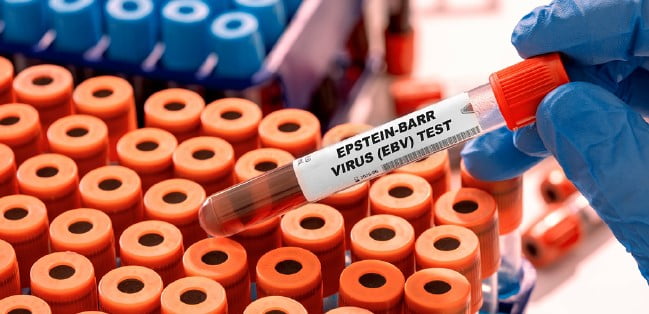
Over the past several months, there has been increased interest in the relationship between the Epstein Barr Virus and multiple sclerosis. A study conducted by a Harvard University research team was published in the journal Science earlier this year and provided strong evidence to support a long-postulated theory that Epstein Barr Virus is a trigger of MS. Let’s examine what we know now about this association and what questions remain.
Epstein Barr Virus (EBV) is one of nine human herpes double-stranded DNA viruses. It’s the cause of mononucleosis and is linked with B cell cancers such as Burkitt’s and Hodgkin’s lymphomas.
It’s also one of the most common viruses in humans. In fact, approximately 94 percent of the population worldwide has been infected with EBV. And approximately 99 percent of people with MS have been infected with EBV. Once infected, the virus stays in the body throughout a person’s lifetime and there is no treatment that can eliminate the virus from the system.
In the large Harvard study, researchers analyzed blood samples from 10 million young adults in the US military. In this longitudinal analysis (studying key markers in individuals over time), they were able to identify 801 individuals who developed MS and 1,566 controls without MS. In those individuals, they looked at specific antibodies that indicate past infection to determine whether EBV was present in the first sample. Then they examined the subsequent additional blood samples to determine the relation between EBV infection and onset of MS. They especially focused on individuals who had NOT been exposed to EBV prior to entering the military.
In analyzing samples taken at three different time points, they found that the risk of MS increased 32-fold after infection with EBV in those who previously had not been exposed to EBV. Further, they found that the risk of developing MS was not increased after infection with other viruses. They demonstrated that becoming infected with EBV significantly increases the risk for developing MS in individuals with other susceptibility factors including genetic background, environment, and lifestyle factors.
The researchers also examined levels of neurofilament light (NfL), which is a molecule released into spinal fluid and blood when nerve axons are damaged. By looking at NfL they sought to test whether the EBV infection occurred prior to MS-related symptoms and diagnosis. For the individuals with MS who were EBV negative at beginning of study, there was no evidence of elevated NfL until they were infected with EBV. After EBV infection, average levels of NfL were found to be elevated prior to the MS diagnosis.
The study affirms the long-hypothesized theory that the Epstein-Barr virus is one leading trigger of MS, but, importantly, it’s not the sole factor in developing MS. In fact, a breadth of research shows us that MS is caused by a complex combination of genetic and environmental factors, and many questions remain about exactly what comprises that combination of factors.
This study points to the likely role that EBV has in triggering MS in individuals who are already susceptible due to these other factors. It should be noted, however, that while some researchers have found evidence of EBV in brain samples at autopsy, others have not always been able to replicate these findings.
Key questions remain regarding the association between EBV and MS. For example, it is not yet known whether EBV is associated with MS relapses or if it impacts the course of the disease. And, is it possible that we could someday prevent EBV infection?
A study is underway to examine an experimental anti-EBV medication in individuals with MS. There are also several efforts underway to test experimental EBV vaccines, including an effort recently announced by Moderna to test an EBV vaccine in healthy adults.
Identifying ways to prevent or manage impacts of an EBV infection, particularly in those individuals who are at highest risk for developing MS, may play a key role in helping to prevent MS.

